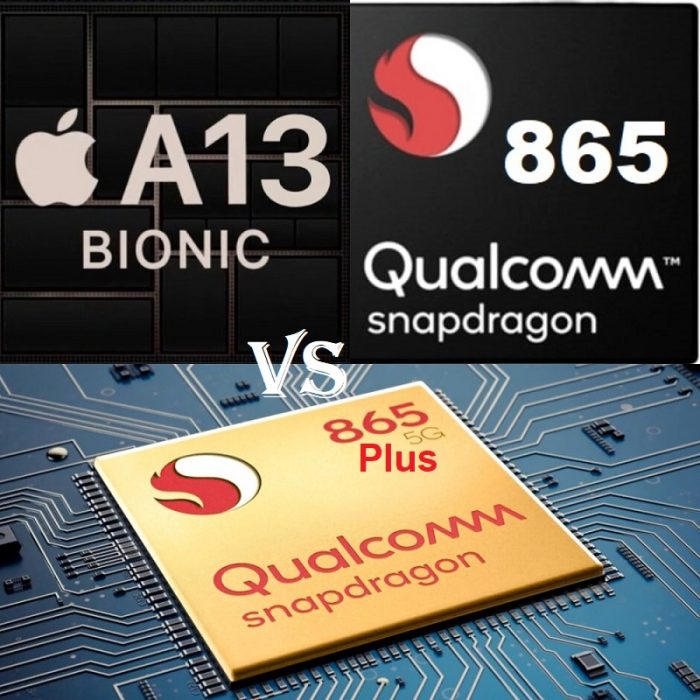Qualcomm is a market leader when it comes to manufacturing mobile chipsets. Almost all the major Android smartphone manufacturers use Snapdragon chipsets for there devices produced by Qualcomm. Lately, the company announced its latest flagship SoC named Snapdragon 865 Plus, which is an upgraded version of vanilla Snapdragon 865. At the same time, there are some other competitions like Apple, who design customized chips for its devices. Its most recent one is Apple A13 Bionic. That is being used the latest iPhone 11 series, the latest iPad, and some other newly launched Apple devices.
However, there is no direct competition between Qualcomm and Apple as both are producing their chipsets for different platforms. The Apple A13 is purely customized for iOS devices. But Qualcomm is covering a wide range of devices from different manufacturers. So, Apple has a clear edge when it comes to making customization for specific devices to enhance performance. But still, people are curious to know how these mobile platforms stand against each other. In this article, we will be comparison the Qualcomm Snapdragon 865 Plus vs Snapdragon 865 vs Apple A13 Bionic. So, without any further ado, let’s get started!
Recommended: Apple A14 Bionic vs A13 vs A12 vs Snapdragon 865+
Snapdragon 865+ vs 865 vs Apple A13 Bionic Specifications Comparison
Central Processing Unit (CPU)
The Qualcomm Snapdragon 865 uses the tri-cluster octa-core CPU, where one Kryo 585 core clocks at 2.84GHz, 3x Kryo 585 cores @2.4GHz, and 4x Kryo 385 cores are cloaked @1.8GHz. If you aren’t aware, their cores use Arm’s latest Cortex-A77 architecture for high performance, whereas power efficiency is taken care of Cortex-A55. Kryo is just a term to display the company’s customizations for the specific cores.
Moving to the Snapdragon 865 Plus, it is just an upgraded version of 865 with one powerful core clock at 3.1GHz, which makes it the industry’s first chipset to cross the 3GHz mark. The rest of the specs are the same as Snapdragon 865. The Apple powered A13 Bionic SoC uses dual-cluster architecture with 2x Lightning cores @2.66 GHz and 4x unspecified frequency Thunder efficiency cores. However, on-paper it looks slightly behind the Snapdragon duo. But it highly customized for the iOS platform. So, it produces insane performance, which can be provided as much as desktop-grade power as the company claims.
In real-world usage, you won’t feel any noticeable difference. But Apple takes advantage of its ecosystem to bring a seamless performance to iOS devices. All three chipsets are manufacturer on TSMS’s 7nm FinFET process to make there more power-efficient. The 7nm (N7P) DUV-
Graphics Processing Unit (GPU)
As far as graphics are concerned, Snapdragon 865 duo brings Adreno 650 GPU. But the company claims to enhance the graphics performance by 10% on the latest Snapdragon 865+ variant. Moreover, Apple uses its own designed quad-core GPU on the A13 Bionic chip. We have seen some impressive benchmark results on all the three SoCs, which we will discuss later in this article.
Overall, GPU is mighty to handle any kind of graphics-intensive tasks, whether it is Snapdragon 865 series or Apple A13 Bionic. The GPU is very much comparable to each other, but Apple takes the edge when offering enhanced sensitivity in most of the games due to the next level of customizations.
Also Read: Snapdragon 720G vs 730G vs 765G vs MediaTek Helio G90T – Antutu-Geekbench Benchmark Scores
Artificial Intelligence (AI)
Artificial intelligence is playing a vital role in the evolution of the smartphone industry. Our phones are becoming smarter and smarter due to AI advancement. Both Apple and Qualcomm know it very well. That is why they are more focusing to implement useful AI features into there mobile platforms. Starting with Snapdragon 865 and SD865+, these chipsets arrive with the 5th generation AI engine, which is way more powerful than the last generation.
Now it can handle up to 15 trillion operations / per second with maximum efficiency. It is more the twice of 7 trillion operations supported by the Snapdragon 855 series. The AI engine also combines the Qualcomm sensing hub. Which accurately detects the voice always-on contextual awareness for smarter virtual assistants. Some other useful features are available such as real-time translation, scene detection, text recognition, super resolutions in snapshots, face authentication, dual and single-camera bokeh.
Moving to the Apple A13 Bionic, It consolidates an octa-core Neural Engine to handle AI tasks. The Deep Fusion technology combines four photos before pressing the shutter. While the other 4 when you do and then one long exposure. Then it picks the best shots and combines them all. There are some other AI integrations that will help to manage different things on iOS devices. Apple didn’t highlight most of the AI features, but AI is present everywhere in the A13 Bionic chip to accomplish different things.
Antutu-Geebench Benchmark Scores
Before moving to the benchmark scores, we want to clarify that we have taken into consideration the latest versions of both Antutu and Geekbench. Starting from the latest Snapdragon 865 Plus, it scores 667,253 points in a leaked Antutu v8 listing. The Snapdragon 865 is already there since 2019. Therefore, we have lots of flagship devices using this chipset—the SoC scores around 5,75,000 points in the Antutu benchmark test. Lastly, Apple powered A13 Bionic comes into the last position with 5,16,681 points in the latest Antutu listing.

On the other hand, there is a big difference between these three SoCs as Apple produces insane chips when it comes to the CPU. Apple A13 Bionic almost crushed the competition with 1,326 points in single-core and 3,381 points in the multi-core result on Geekbench 5. Snapdragon 865 Plus scores the second position with 973 points in Single-Core and 3,346 points in the multi-core test. Vanilla Snapdragon 865 incorporates 923 points in Single-Core and 3,267 points in the multi-core test. However, there isn’t a big difference between multi-core results, but Apple A13 dominates single-core on Geekbench 5 results.

Connectivty
This is the criteria where Apple A13 Bionic legs behind the Qualcomm. Because both Snapdragon 865 and 865 Plus SoCs arrive with 5G support. However, 5G is still a dream for the developing country. But it could be a key selling point in the developed world, where 5G technology is available. The Snapdragon 865 duo supports X55 5G modem to deliver high-speed 5G internet. Another good thing is that it supports dual-mode SA/NSA 5G connectivity, which means it can switch between 4G and 5G according to their reach. The solution can be convenient because 5G isn’t very well established in most of the countries.
As for speed, the Qualcomm X55 modem can deliver up to 7Gbps download and 3Gbps upload speed under the 5G range. The speed will be 2.5Gbps download and 316Mbps upload under the 4G connectivity. There is no doubt that Apple A13 Bionic stands behind the Snapdragon 865 series. But it performs very well in the network area, though the speed is limited to 4G LTE only. Other necessarily connectivity features such as WiFi 6 and the latest Bluetooth 5.1 is available on all three chipsets. But Qualcomm takes it to one step ahead with WiFi 6E and Bluetooth 5.2 support on Snapdragon 865 Plus.
Read More: Snapdragon 765G vs 865 vs 855 vs 845 – AnTuTu-Geekbench Benchmark Scores
Final Verdict – Which one is better?
Before reaching the final decision, Apple A13 takes explicit advantage of its ecosystem to deliver better performance in most areas. In contrast, Qualcomm struggle to change its design accordingly to the demand of different manufacturers. Various smartphone manufacturers are using Qualcomm chipsets. Still, the company is doing a great job to produce some powerful chipsets in the industry. Both Snapdragon 865 and 865 Plus are the prime example.
If you are the iPhone users, you must have noticed that your iPhone works very well without becoming slow overtime. Apple designs chips for there own use. So, they are more comfortable to deliver timely updates to maintain performance. But Android OEMs can’t provide similar long-term experience as they are working third part for both the Operating System provider and chip manufacturer. But when it comes to connectivity, Qualcomm has a clear edge due to the 5G support.
The Snapdragon 865 series is well capable of delivering high-speed internet in comparison to the Apple A13 Bionic chipset. All in all, there isn’t a clear winner at all. There is no doubt that Apple A13 Bionic delivers way more powerful CPU and GPU performance because of fewer bottlenecks. At the same time, Snapdragon 865 has better connectivity. But there is no competition when it comes to choosing an ecosystem. Those who like iOS will have to go for Apple A13 Bionic. Qualcomm Snapdragon 865 Plus is one of the most impressive chipsets ever for Android phones. It gets around 10% CPU and GPU boost in comparison to standard Snapdragon 865 SoC.


